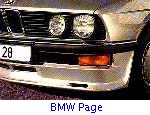 Procedure
ProcedureI attended a Driver's School at New Hampshire International Speedway in October 1994. With a high mileage car, I underestimated the actual costs of the school. While the $90 entrance fee was reasonable for anyone considering attending, one must not forget to consider the preparatory costs as well as the costs of repairing damage. The obvious lemma is that the more time/money invested prior to school, the less time/money required after school.
I broke this rule. After not replacing the original lower control arms (containing lower ball joints and lower control arm bushings) with 227k miles on them, I blew apart a wheel bearing. So, instead of spending a gorgeous weekend in the mountains after the school ended, I found myself repairing my broken car. The E28 front bearings are expensive to buy, but they do last about 200k miles. They're even more expensive when your car has ABS (my 1983 doesn't). I limped home and spent the better part of Saturday searching for a new wheel bearing, and Sunday in the Zen Buddhist exercise of conquering the bolts.
Having suffered some pain, and learned a bit, here is the definitive procedure. If you have reasonable mechanical competence, this is surely a do-it-yourself job. I can add this one to the list of "why did I ever consider paying someone to do this??" jobs.
NOTE: This work was done with the rear wheels on ramps, and the front wheels on jack stands (with the floor jack remaining in place... just in case). A lift indeed isn't required, although it would have made the job a bit easier.
 Procedure
Procedure
One side note: If you ever need to replace a wheel bearing, don't panic, as I did, if the inner race pops out of the new wheel bearing before you tap it onto the spindle. The solution to reinserting it is the following, thanks to our friend, Roland Freund:
Remove the rear seal. Then remove the bearings, carefully, in its cage. Then slide the bearings around the race and reinsert it. Reinsert the seal, evenly. Fortunately, if the outer race comes out, you can insert it by simply placing it in the hub at an angle, and it slips in place. Also, another hint: To tap the new hub/bearing assembly onto the spindle, *don't* hit the hub or the outer race will surely pop out. Take the 1-13/16 (or 46mm) socket that you used to get the nut off, place it over the outer race, and tap away.
Thanks to Roland Freund for his technical advice, Jim Conforti for his moral support and male bonding (he usually torques electrons and passengers 8^)), and Charles Karnati for the 1-13/16 socket and the torque specs.



 Steve's Home Page
Steve's Home Page 